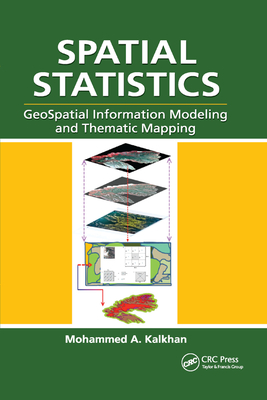Statistical Analysis of Geographic Information with ArcView GIS And ArcGIS
暫譯: 使用 ArcView GIS 和 ArcGIS 的地理資訊統計分析
David W. S. Wong, Jay Lee
- 出版商: Wiley
- 出版日期: 2005-10-01
- 售價: $5,720
- 貴賓價: 9.5 折 $5,434
- 語言: 英文
- 頁數: 464
- 裝訂: Hardcover
- ISBN: 0471468991
- ISBN-13: 9780471468998
-
相關分類:
地理資訊系統 Gis
下單後立即進貨 (約1~3週)
買這商品的人也買了...
-
 Visual C#.NET 程式設計經典
Visual C#.NET 程式設計經典$650$514 -
 $780CMMI: Guidelines for Process Integration and Product Improvement (Harcover)
$780CMMI: Guidelines for Process Integration and Product Improvement (Harcover) -
 ASP.NET 程式設計徹底研究
ASP.NET 程式設計徹底研究$590$466 -
 Building Embedded Linux Systems
Building Embedded Linux Systems$1,710$1,625 -
 數位邏輯設計 (Digital Design, 3/e)
數位邏輯設計 (Digital Design, 3/e)$580$568 -
 重構─改善既有程式的設計
重構─改善既有程式的設計$720$569 -
 資訊與網路安全技術
資訊與網路安全技術$680$578 -
 Windows 程式設計使用 MFC (Programming Windows with MFC, 2/e)
Windows 程式設計使用 MFC (Programming Windows with MFC, 2/e)$990$782 -
 $1,064The 3G IP Multimedia Subsystem (IMS) : Merging the Internet and the Cellular Worlds
$1,064The 3G IP Multimedia Subsystem (IMS) : Merging the Internet and the Cellular Worlds -
 Windows CE.NET 程式設計 (Programming Microsoft Windows CE .Net, 3/e)
Windows CE.NET 程式設計 (Programming Microsoft Windows CE .Net, 3/e)$890$703 -
 多媒體圖學基礎與 Web 3D 初級實作
多媒體圖學基礎與 Web 3D 初級實作$400$340 -
 Reversing: Secrets of Reverse Engineering (Paperback)
Reversing: Secrets of Reverse Engineering (Paperback)$1,300$1,235 -
 最新詳解 Javascript & HTML & CSS 語法辭典(增訂新版)
最新詳解 Javascript & HTML & CSS 語法辭典(增訂新版)$490$382 -
 $1,127Database System Concepts, 5/e (IE) (美國版ISBN:0072958863)
$1,127Database System Concepts, 5/e (IE) (美國版ISBN:0072958863) -
 深入淺出 Java 程式設計, 2/e (Head First Java, 2/e)
深入淺出 Java 程式設計, 2/e (Head First Java, 2/e)$880$695 -
 思科全球網路學會 CCNA 1 & 2 中文版 (Cisco Networking Academy Program CCNA 1 and 2 Companion Guide, Revised, 3/e)
思科全球網路學會 CCNA 1 & 2 中文版 (Cisco Networking Academy Program CCNA 1 and 2 Companion Guide, Revised, 3/e)$880$695 -
 Linux Mail Server 技術實務─架設、稽核、防毒、防垃圾信
Linux Mail Server 技術實務─架設、稽核、防毒、防垃圾信$580$493 -
 輕輕鬆鬆學會 Linux Kernel Module 及 TCP/IP 程式設計
輕輕鬆鬆學會 Linux Kernel Module 及 TCP/IP 程式設計$350$315 -
 深入淺出 Hibernate
深入淺出 Hibernate$650$507 -
 SQL Server 2005 資料庫開發聖經
SQL Server 2005 資料庫開發聖經$890$757 -
 SQL Server 2005 資料採礦聖經
SQL Server 2005 資料採礦聖經$650$553 -
 Spring 技術手冊
Spring 技術手冊$580$458 -
 鳥哥的 Linux 私房菜基礎學習篇, 2/e
鳥哥的 Linux 私房菜基礎學習篇, 2/e$780$663 -
 ASP.NET 2.0 深度剖析範例集
ASP.NET 2.0 深度剖析範例集$650$507 -
 ASP.NET 應用程式開發─與 AJAX 共舞
ASP.NET 應用程式開發─與 AJAX 共舞$620$490
商品描述
Description
Statistical Analysis and Modeling of Geographic Information with ArcView GIS is an update to Lee and Wong's Statistical Analysis with ArcView GIS, featuring expanded coverage of classical statistical methods, probability and statistical testing, new student exercises to facilitate classroom use, new exercises featuring interactive ArcView Avenue scripts, and a new overview of compatible spatial analytical functions in ArcGIS 9.0.
Table of Contents
PREFACE.
ACKNOWLEDGMENTS.
1 INTRODUCTION.
1.1 Why Statistics and Sampling?
1.2 What Are Special about Spatial Data?
1.3 Spatial Data and the Need for Spatial Analysis/ Statistics.
1.4 Fundamentals of Spatial Analysis and Statistics.
1.5 ArcView Notes—Data Model and Examples.
PART I: CLASSICAL STATISTICS.
2 DISTRIBUTION DESCRIPTORS: ONE VARIABLE (UNIVARIATE).
2.1 Measures of Central Tendency.
2.2 Measures of Dispersion.
2.3 ArcView Examples.
2.4 Higher Moment Statistics.
2.5 ArcView Examples.
2.6 Application Example.
2.7 Summary.
3 RELATIONSHIP DESCRIPTORS: TWO VARIABLES (BIVARIATE).
3.1 Correlation Analysis.
3.2 Correlation: Nominal Scale.
3.3 Correlation: Ordinal Scale.
3.4 Correlation: Interval /Ratio Scale.
3.5 Trend Analysis.
3.6 ArcView Notes.
3.7 Application Examples.
4 HYPOTHESIS TESTERS.
4.1 Probability Concepts.
4.2 Probability Functions.
4.3 Central Limit Theorem and Confidence Intervals.
4.4 Hypothesis Testing.
4.5 Parametric Test Statistics.
4.6 Difference in Means.
4.7 Difference Between a Mean and a Fixed Value.
4.8 Significance of Pearson’s Correlation Coefficient.
4.9 Significance of Regression Parameters.
4.10 Testing Nonparametric Statistics.
4.11 Summary.
PART II: SPATIAL STATISTICS.
5 POINT PATTERN DESCRIPTORS.
5.1 The Nature of Point Features.
5.2 Central Tendency of Point Distributions.
5.3 Dispersion and Orientation of Point Distributions.
5.4 ArcView Notes.
5.5 Application Examples.
6 POINT PATTERN ANALYZERS.
6.1 Scale and Extent.
6.2 Quadrat Analysis.
6.3 Ordered Neighbor Analysis.
6.4 K-Function.
6.5 Spatial Autocorrelation of Points.
6.6 Application Examples.
7 LINE PATTERN ANALYZERS.
7.1 The Nature of Linear Features: Vectors and Networks.
7.2 Characteristics and Attributes of Linear Features.
7.3 Directional Statistics.
7.4 Network Analysis.
7.5 Application Examples.
8 POLYGON PATTERN ANALYZERS.
8.1 Introduction.
8.2 Spatial Relationships.
8.3 Spatial Dependency.
8.4 Spatial Weights Matrices.
8.5 Spatial Autocorrelation Statistics and Notations.
8.6 Joint Count Statistics.
8.7 Spatial Autocorrelation Global Statistics.
8.8 Local Spatial Autocorrelation Statistics.
8.9 Moran Scatterplot.
8.10 Bivariate Spatial Autocorrelation.
8.11 Application Examples.
8.12 Summary.
APPENDIX: ArcGIS Spatial Statistics Tools.
ABOUT THE CD-ROM.
INDEX.
商品描述(中文翻譯)
**描述**
《使用 ArcView GIS 進行地理資訊的統計分析與建模》是對 Lee 和 Wong 的《使用 ArcView GIS 進行統計分析》的更新版,擴展了對經典統計方法、機率和統計檢定的涵蓋範圍,新增了便於課堂使用的學生練習,包含互動式 ArcView Avenue 腳本的新練習,以及對 ArcGIS 9.0 中相容的空間分析功能的新概述。
**目錄**
前言
致謝
**1 引言**
1.1 為什麼要學習統計和抽樣?
1.2 空間數據有什麼特別之處?
1.3 空間數據與空間分析/統計的需求。
1.4 空間分析和統計的基本原理。
1.5 ArcView 註解—數據模型和範例。
**第一部分:經典統計**
**2 分佈描述符:單變量(UNIVARIATE)**
2.1 集中趨勢的測量。
2.2 雜散度的測量。
2.3 ArcView 範例。
2.4 高階矩統計。
2.5 ArcView 範例。
2.6 應用範例。
2.7 總結。
**3 關係描述符:雙變量(BIVARIATE)**
3.1 相關分析。
3.2 相關:名義尺度。
3.3 相關:序數尺度。
3.4 相關:區間/比率尺度。
3.5 趨勢分析。
3.6 ArcView 註解。
3.7 應用範例。
**4 假設檢定**
4.1 機率概念。
4.2 機率函數。
4.3 中心極限定理和信賴區間。
4.4 假設檢定。
4.5 參數檢定統計。
4.6 平均數之間的差異。
4.7 平均數與固定值之間的差異。
4.8 Pearson 相關係數的顯著性。
4.9 回歸參數的顯著性。
4.10 測試非參數統計。
4.11 總結。
**第二部分:空間統計**
**5 點模式描述符**
5.1 點特徵的性質。
5.2 點分佈的集中趨勢。
5.3 點分佈的雜散度和方向性。
5.4 ArcView 註解。
5.5 應用範例。
**6 點模式分析器**
6.1 規模和範圍。
6.2 四分位數分析。
6.3 有序鄰居分析。
6.4 K-函數。
6.5 點的空間自相關。
6.6 應用範例。
**7 線模式分析器**
7.1 線性特徵的性質:向量和網絡。
7.2 線性特徵的特徵和屬性。
7.3 方向統計。
7.4 網絡分析。
7.5 應用範例。
**8 多邊形模式分析器**
8.1 介紹。
8.2 空間關係。
8.3 空間依賴性。
8.4 空間權重矩陣。
8.5 空間自相關統計和符號。
8.6 聯合計數統計。
8.7 空間自相關全局統計。
8.8 局部空間自相關統計。
8.9 Moran 散佈圖。
8.10 雙變量空間自相關。
8.11 應用範例。
8.12 總結。
**附錄:ArcGIS 空間統計工具**
**關於 CD-ROM**
**索引**





















